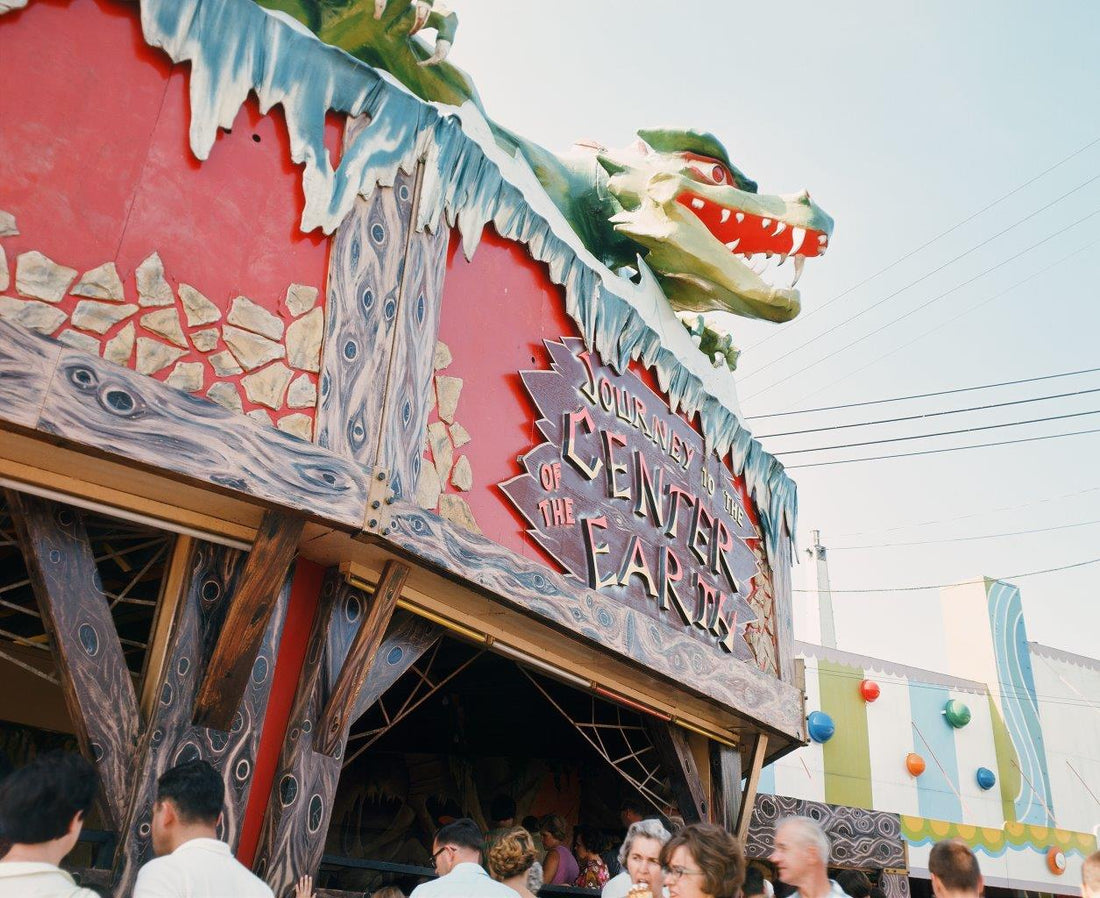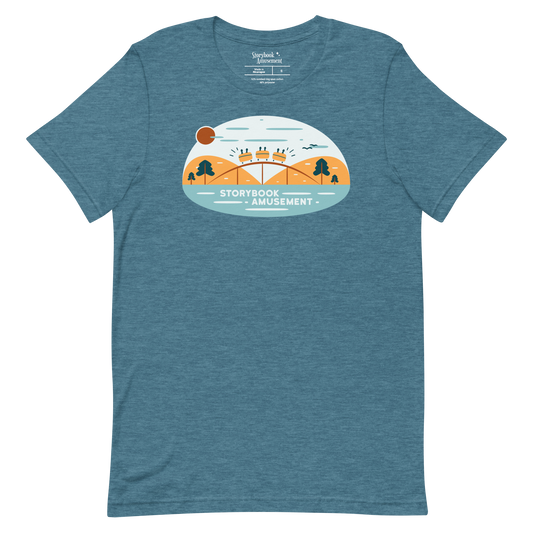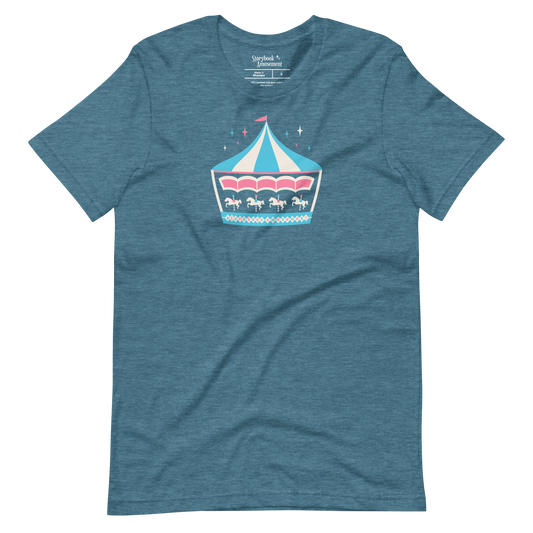The history of Dorney Park is a journey in itself—a journey that dates back to 1774.
Watch on YouTube
This article is available in video form with added visuals. Click HERE to watch it.
Daniel Dorney bought nearly 300 acres of land along the Cedar Creek in Allentown, Pennsylvania. Nearly a century later, Daniel’s grandson, Solomon, had used the property as a fish hatchery where he made a living selling fish to markets and restaurants across the nation.
Solomon Dorney later opened the waterside park to the public. At Fish Weir and Summer Resort, visitors could fish from several trout ponds and enjoy the park’s shady picnic groves.
Business was going swimmingly as the property steadily grew into an attraction. By the 1870s, the park had gained a few playground-style rides and other offerings, such as a zoo, games, and refreshments. Perhaps its biggest addition was a hotel and restaurant. The park, which was once mostly for anglers, was becoming something more special.
Into the next decade, the park was attracting hundreds of thousands of visitors per year. The year 1884 was a turning point for the destination. The property was then renamed to Dorney's Trout Ponds and Summer Resort, and thus propelled its sure potential as an amusement park.
The destination—eventually to be named Dorney Park—improved year after year with new attractions such as a Ferris wheel. Dorney Park’s new swimming pool was marketed as the largest in the world. In due time, the park got a carousel, which was a standout at Dorney Park.
Thrills Come to Dorney Park
Headed into the 1920s, the once-simple picnic grove was preparing for a thrilling decade. Dorney Park planned to invest $30,000 over the coming years, making improvements and additions to the park. Robert Plarr took over as Dorney Park’s president in the early 1920s. Under his leadership, Dorney Park was well-cared-for, with no shortage of mainstay attractions.
In 1924, Dorney Park added a major new thrill with its first roller coaster, simply named Coaster. The wooden coaster was built by industry leaders, Philadelphia Toboggan Company (PTC). Coaster was a massive success that transformed Dorney Park and laid the foundation of its productive relationship with PTC.
More Rides on the Way
Opening up shop a few years after the turn of the century, PTC made their mark by crafting beautifully hand-carved carousels as found across the nation to this day. PTC also became well-known for manufacturing early wooden roller coasters for amusement parks and local trolley parks.
PTC gained momentum through the decades, just as Dorney Park did. A few years after the opening of Dorney Park’s Coaster, PTC returned to Allentown to expand its amusement offerings—not with a coaster, but rather with one of PTC’s other designs.
Meanwhile, parks across the globe were adding the increasingly popular old mill ride type, also known as the tunnel of love. These rides became a bit of a phenomenon among couples looking for some privacy. However, the old mill wasn’t the only boat ride model crowds were falling in love with: Shoot the chute rides had been installed one after another at park after park. These rides made a splash, combining thrill with a refreshing way for riders to cool off.
Dorney Park and PTC had their eyes set on these types of rides, but they wouldn’t pick one or the other.
Dorney Park's Mill Chute
In 1927, Dorney Park built its newest ride, Mill Chute, which was an old mill combined with a shoot the chute, built by PTC.
The load station had a painted mural themed to an old mill as riders boarded into small boats. Guests in line could watch as the boats dispatched. Once in the free-flowing water, the boats bumped and bobbed through dark tunnels. This portion of the ride was slow and gentle, as swells of water moved through the stream each time a boat splashed into the canal.
The flume meandered its way to a chain lift where boats were raised out of the water and steadily climbed to the top. The boats then scooted down a drop that curved to the right, plunging into a splashdown. The lift and drop used a coaster-like structure, courtesy of PTC, which made for an intense finale. Once doused with water, the boats floated back to the station where guests exited the ride.
Mill Chute was instantly among Dorney Park’s more popular rides, being commonly advertised as a headlining attraction along with Coaster. In fact, Mill Chute was located adjacent to Coaster. It operated for several years and received updates every few seasons, such as new surprises in the tunnel and an updated facade after a few years.
Mill Chute lasted for several decades in its original form, but Dorney Park transformed over those years. Robert Plarr, as the head of the park, was very involved in making Dorney Park a memorable destination. Approaching the 1960s, Dorney Park had received consistent maintenance, additions, and improvements. The long-running Mill Chute lost its shine, now decades removed from its inaugural season in the ‘20s.
Dorney Park celebrated its 75th anniversary in 1959, which would be the final season for the classic version of Mill Chute.
A Shift in Theming
The debut of Disneyland Park in 1955 undoubtedly changed the amusement park industry. The well-themed and well-kept Disneyland inspired amusement parks and designers from all over.
Around this time, designer Bill Tracy started to make a name for himself. Tracy became known for his detailed work creating themed sets in circuses, amusements, and parades, as he expanded his work to local parks.
That’s when Tracy and Dorney Park partnered up. By the following season, Mill Chute would have an entirely new theme, thanks to the creative work of Bill Tracy—who’s credited for creating Dorney Park’s iconic Alfundo marquee.
The rethemed attraction would take riders into the mind of Jules Verne and his 1864 sci-fi novel, Journey to the Center of the Earth. The legendary Bill Tracy reworked the tunnels of Mill Chute to feature a few displays with the creatures as described in Verne’s work. The lift hill and drop remained mostly the same.
The Journey to the Center of the Earth Ride Experience
Journey to the Center of the Earth opened at Dorney Park in 1960.
The rethemed water ride brought a menacing prescience to the park. Its imposing facade was intricate with magma and stalactites—under the fierce protection of an archaeopteryx-like monster. With glowing red eyes at night, the ride’s marquee made a statement on the midway with a nice reflection in the shimmering lagoon.
Journey to the Center of the Earth functioned the same as when it was Mill Chute, sending boats through dark tunnels, up a lift hill, down a drop, and back to the station.
The tunnels sent riders on an expedition to discover the prehistoric unknowns found under the earth’s surface. Along the stream were Jules-Verne-inspired displays—the details of which are largely undocumented in the ride’s early days. The animated scenes were set up in various cave-themed window sets, including volcanic spectacles with monsters from Verne’s novel.
Along the splashdown, the boats passed by a few creatures dwelling in the rockwork.
The Ride's Success
Regardless of the details, Journey to the Center of the Earth was a massive hit for Dorney Park at the time.
“Way back in the ‘50s, we were getting 15 cents a ride for [the Mill Chute]. When we redesigned it, working with Bill Tracy, we doubled the price, which at that time was terrific—going from 15 cents to 30 cents.”
— Robert Ott, former park president
Journey to the Center of the Earth continued as a fan-favorite ride at Dorney Park. It was a great way to cool off and enjoy some original theming found only at Dorney Park. Of course, the ride still had its tunnel of love roots. From its opening day in 1960 and into the 1980s, Journey to the Center of the Earth was popular for many reasons.
A Revised Journey
Dorney Park celebrated its 100th anniversary in the ‘80s; that same decade, the park renovated Journey to the Center of the Earth, saying the ride would have a, “More cave-like experience with new surprises inside.”
After the remodel, Journey to the Center of the Earth sported an arctic blue facade—in place of the volcanic aesthetic—and updated lettering that displayed the ride’s name in a new way. The covered queue area was lined with spider webs to set the spooky spirit of the attraction.
Inside, the attraction focused less on the Jules Verne source material, in favor of general scary sets inside the ride’s caverns. The first scene in the revamped ride was a reptilian monster lurking in the cave. Farther along, someone was caged up next to some trolls playing cards. Riders then floated by a massive spider, intimidating anyone with arachnophobia. Approaching the end of the tunnel, the boat passed by monsters preparing a meal.
The scenes had nice lighting effects, but overall minimal movements from the figures. Still, the damp tunnel, dark environment, creepy sound effects, and terrifying sets made for a simply unnerving experience.
Through the years, the ride’s coaster-like splashdown climax remained the same. Riders enjoyed Mill Chute and Journey to the Center of the Earth for the better part of a century, but Dorney Park was headed in a new direction.
Dorney Breaks Records, Changes Ownership
In 1989, Dorney Park debuted one its most ambitious rides in the park’s history: Hercules. Hercules held the record for having the longest drop on a wooden coaster, being 151 feet.
Having a record-breaking coaster was important to Dorney Park. This was made clear in the contract between Dorney Park and the manufacturer that built the coaster, Dinn Corporation. The contract stated Dinn Corp could not built another coaster larger than Hercules for at least two years.
Dorney Park was clearly ramping up the intensity, going full speed into a new decade.
Cedar Fair Entertainment Company—the parent company that owned Ohio’s Cedar Point and Minnesota’s Valleyfair—saw potential in Dorney Park. In 1992, Dorney Park would change forever; Cedar Fair bought Dorney Park for $48 million: the first park Cedar Fair ever acquired.
Dorney Park was now under new ownership.
Journey's End
Cedar Fair was ambitious with the humble Dorney Park, focusing on optimized efficiency, costs, and guest satisfaction. The company made immediate changes for the upcoming season. Those offseason updates meant longtime fans wouldn’t have an opportunity to properly say goodbye to a fan-favorite.
With no prior announcement, Cedar Fair made the difficult decision to close and demolish Journey to the Center of the Earth. Those who rode Journey to the Center of the Earth in 1992 rode it for their final time without knowing it was their final time.
The ride lasted through numerous decades, several revisions, and countless irreplaceable memories along the way.
The historic ride was removed for expanded midways and upcoming improvements.
Park officials justified the ride’s closure, saying maintenance was labor intensive, replacement parts were hard to get, and the ride itself was leaking water. The worn-out ride system built earlier in the century wasn’t worth the effort for Dorney Park’s new owners. Time stops for no attraction as the aging boat ride had reached the end of its service life.
However, Journey to the Center of the Earth was a low-capacity attraction, meaning it could accommodate only a limited number of guests per hour. Park officials stated they couldn’t find a way to improve that issue.
Although the ride’s removal was disappointing, a park spokesperson, Scott Blueblood, was optimistic for Dorney Park’s future and the attraction’s past, saying, “We’re going to be adding a major attraction every season. At the same time, we’re going to keep as many of the historic rides as possible. It’s not always possible. We’re not a museum here; we’re an amusement park.”
A Dorney Park marketing official, Michael Crowther, shared a realistic perspective on the status of Journey to the Center of the Earth, saying, “What we’re doing is improving Dorney Park. Journey to the Center of the Earth did not deliver. The marquee made the ride look exciting, but it disappointed.”
Dearly Missed
Fans on the other hand were saddened by the loss of Journey to the Center of the Earth. Parkgoers reminisced about the ride’s signature smell, pitch-black effect, unique theming, and bumpy channel; those were all simple sensations that were essential to a summer visit to Dorney Park—sensations that couldn’t be replicated anywhere other than Allentown.
Dorney Park’s former president, Robert Ott, was understanding but impacted by the decision, saying he, “got a tear in [his] eye when [he] heard it was coming out.”
“[Journey to the Center of the Earth] was a throwback to the past when a thrill wasn’t measured by height or speed.”
— Susan Todd, The Morning Call
The Past, Present, and Future of Dorney Park
Today, Dorney Park retains some of its history as Coaster still operates to this day, now under the name Thunderhawk. The classic wooden coaster is approaching its 100th season and has been awarded a landmark plaque by the American Coaster Enthusiasts organization.
Journey to the Center of the Earth is a timeless story that has made its way into other theme parks, namely Tokyo DisneySea. Journey to the Center of the Earth at Tokyo DisneySea, although no relation to Dorney Park, takes riders on an astounding adventure worth writing home about.
The old mill and shoot the chute ride types still exist here and there around various amusement parks. Next time you get the chance to ride one—or any historic attraction—appreciate what’s still there, still standing, and still thrilling guests after all these years.





